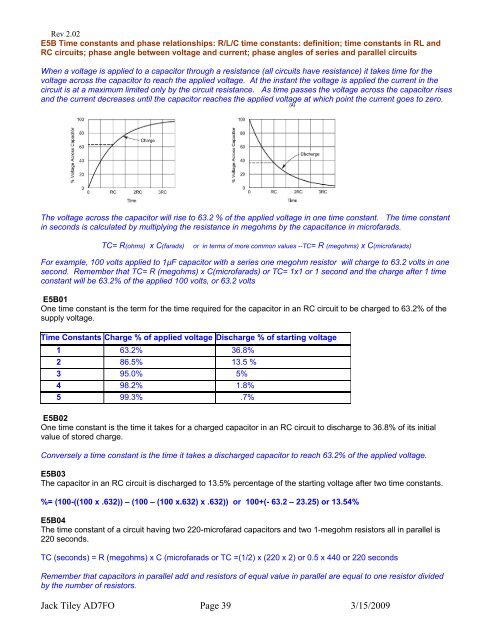You also want an ePaper? Increase the reach of your titles
YUMPU automatically turns print PDFs into web optimized ePapers that Google loves.
Rev 2.02<br />
E5B Time constants and phase relationships: R/L/C time constants: definition; time constants in RL and<br />
RC circuits; phase angle between voltage and current; phase angles of series and parallel circuits<br />
When a voltage is applied to a capacitor through a resistance (all circuits have resistance) it takes time for the<br />
voltage across the capacitor to reach the applied voltage. At the instant the voltage is applied the current in the<br />
circuit is at a maximum limited only by the circuit resistance. As time passes the voltage across the capacitor rises<br />
and the current decreases until the capacitor reaches the applied voltage at which point the current goes to zero.<br />
The voltage across the capacitor will rise to 63.2 % of the applied voltage in one time constant. The time constant<br />
in seconds is calculated by multiplying the resistance in megohms by the capacitance in microfarads.<br />
TC= R(ohms) x C(farads) or in terms of more common values --TC= R (megohms) x C(microfarads)<br />
For example, 100 volts applied to 1µF capacitor with a series one megohm resistor will charge to 63.2 volts in one<br />
second. Remember that TC= R (megohms) x C(microfarads) or TC= 1x1 or 1 second and the charge after 1 time<br />
constant will be 63.2% of the applied 100 volts, or 63.2 volts<br />
E5B01<br />
One time constant is the term for the time required for the capacitor in an RC circuit to be charged to 63.2% of the<br />
supply voltage.<br />
Time Constants Charge % of applied voltage Discharge % of starting voltage<br />
1 63.2% 36.8%<br />
2 86.5% 13.5 %<br />
3 95.0% 5%<br />
4 98.2% 1.8%<br />
5 99.3% .7%<br />
E5B02<br />
One time constant is the time it takes for a charged capacitor in an RC circuit to discharge to 36.8% of its initial<br />
value of stored charge.<br />
Conversely a time constant is the time it takes a discharged capacitor to reach 63.2% of the applied voltage.<br />
E5B03<br />
The capacitor in an RC circuit is discharged to 13.5% percentage of the starting voltage after two time constants.<br />
%= (100-((100 x .632)) – (100 – (100 x.632) x .632)) or 100+(- 63.2 – 23.25) or 13.54%<br />
E5B04<br />
The time constant of a circuit having two 220-microfarad capacitors and two 1-megohm resistors all in parallel is<br />
220 seconds.<br />
TC (seconds) = R (megohms) x C (microfarads or TC =(1/2) x (220 x 2) or 0.5 x 440 or 220 seconds<br />
Remember that capacitors in parallel add and resistors of equal value in parallel are equal to one resistor divided<br />
by the number of resistors.<br />
Jack Tiley <strong>AD7FO</strong> Page 39 3/15/2009


